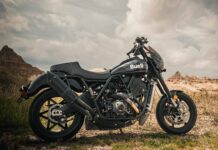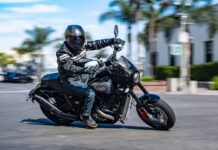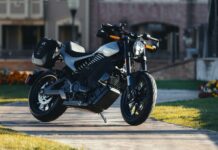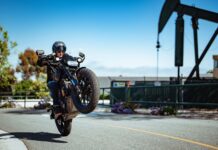Wichita unleashes a hellhound
Riding a whopper… and telling some, too
The Ridgeback has made both a celebrity and a liar out of me and it all started when the Big Dog Motorcycle transporter rolled into my town, which is variously described as a “quaint hamlet,” or a “sleepy farm community,” or a “jerkwater burg.” Suffice to say that it doesn’t take a hell of a lot to cause a stir in these parts where reports of a four-eared jackrabbit sighting is sufficient to bring a crowd down to the general store eager for the details. And, yes, we do have a general store—and three’s still a crowd hereabouts.
Even so, the arrival of the Ridge-back was a sensation an order of magnitude greater than the rabbit, and was, in fact, the biggest source of local buzz since the saloon got shut down for serving the local minor. When that gleaming, larger-than-life chopper was off-loaded on the side street by the abandoned railroad spur, it literally stopped traffic—all three vehicles—and the guy in the first vehicle jumped out, camera phone at the ready, and did a walk-around of the bike, snapping photos and gushing awe and admiration. Shortly thereafter, the Ridgeback now in my driveway, the neighbors—some of whom were still largely strangers despite being my neighbors for 15 years—came a-calling to take a gander at the Dog like it was a red/gray rhino run off from the circus. And then the UPS guy stopped out front and came down the driveway to check the machine out up close while the local minor stole into his step-van and made off with some parcels.
Through all of this, the whoppers had begun to spill from my lips. It just became easier after the first few exchanges and the first few times I was asked, “You build it yourself?” to respond, “Yes, I did. I sure did. Right in my own garage,” rather than truthfully reply, “No, it’s actually a production motorcycle made in Wichita, Kansas, by Big Dog Motorcycles, and it doesn’t actually belong to me, I’m just borrowing it for awhile to photograph and write a review on it for a magazine, which is my job, and, yes, that’s an actual job, and, no, we’re not hiring.” See what I mean?
The second whopper I found myself telling was not quite so defensible. In re-sponse to the invariable second query, “Is it hard to ride something that big?” I answered, “Yes, it’s a real bear. Only a man of towering physical strength, acrobatic agility and highly developed riding skills can wrestle with this monster. Hell, just look at it.” In these instances I could have told the truth in far fewer words—two words, actually: “Not really.” But the truth wouldn’t reflect as heroically on my mettle and epic moto-prowesss, and may even thwart my rising celebrity. The lie seemed the better way to go here.
Sure, this was self-aggrandizement at its baldest, but I was able to rationalize it by figuring that in order to do a meaningful review of the Ridgeback, I would have to embrace my inner show-off, since a robust ego is a central component in owning and riding a bike like this. If you’re the shy, retiring type who prefers to slip through life in relative anonymity, this is a poor choice of conveyance. Everything about the bike, from its fantastic dimensions—fully nine feet in length, with a 12-inch-over front end and an ungodly 330/30-R17 tire in back—to its spare-no-expense application of paint and billet components, its grunting 117-inch S&S motor, and its unique Big Dog/Baker balanced drive primary and direct drive six-speed transmission scream, “Hey! Look at me!” And if that’s not distressing enough, people will want to stop and marvel and talk to you about the machine. The horror.
If, on the other hand, you’re the outgoing type who doesn’t like to settle for arriving someplace when you can positively make an entrance, this is a surefire means of assuring that. No production motorcycle boasts more radical architecture or menacing curbside presence than the Ridgeback.
Which brings us back to that second whopper I took to telling, the one about the bike being a real bear to ride, and quite obviously there are some decidedly bearish elements here to contend with. The hardtail frame and 330 tire are tougher to manage than more conventional outfitting, for sure, but not nearly a tough as you’d suspect when looking at this brute. Acclimating to the immense rear skin is mostly a matter of realizing that it has a tipping point, and should be operated with attentiveness when rolling over a pavement lip, and that it responds more obediently to the laws of inertia than smaller tires—meaning once it gets going in a certain direction, it wants to keep going in that direction and takes proportionately sterner steering inputs to muscle it around a tight curve. Once you’ve conditioned yourself to those demands, though, it’s really no big deal. And it sure tracks stably at slow speeds—it practically stands up straight all by itself. And at high speeds the Ridgeback tracks like a locomotive, owing both to its long wheelbase and to its well-apportioned rake, with 39 degrees in the neck and three degrees in the triple tree.
The hardtail frame brings its own distinctive traits to the ride, traits that at times can be demanding. The combination of that will-ful 330 tire and the inflexible hardtail is, of course, what gives everyone the impression that your own ass is as hard as the bike’s, and the extent to which that impression is justified is reached on twisty back roads. While it’s true that there’s something indescribably cool about the sensation of bossing a fat hardtail through a well-paved sweeper, there’s also something indescribably unnerving about doing the same through a bumpy curve. With no rear suspension to absorb and ride out uneven pavement conditions, the tire can tend to lose touch with both pavement and the pilot’s intentions, making for a real rodeo moment. You need to remain vigilant in reading the lay of the road ahead to minimize these little surprises.
Remarkably, the Ridge-back doesn’t telegraph jolts from the pavement to the spine like you’d expect, and the ride is a smooth one, relatively speaking. The reason for this happy state of affairs lies in the bike’s seat, which has been designed to put a whole mess of cushion right where it matters, and Big Dog has managed to do this without detracting from the long flowing lines of the bike. Even bumps and holes of moderately severe impact can be ridden straight on, butt in the saddle, without your coccyx trying to shake hands with the base of your skull. (Don’t get lulled into complacency, though. There’s always a real thumper up ahead somewhere with your name on it. Take it from me… or my coccyx.)
Remarkable also is the smoothness of the drivetrain on the Ridgeback, starting with the 117-inch motor which, though a big solid-mounted stroker, has virtually no discernible vibration throughout its rev range. Big Dog has been using this motor for several years now, and they’ve got it well and truly dialed in. The Baker transmission is equally refined in this application and virtually impossible to miss-shift or bother. A light clutch pull and easily notched neutral make around-town riding a pleasure, and that direct drive sixth speed makes 75 mph eerily serene. The bike’s ergonomics lend themselves to that style of high-speed cruising, too, with just enough forward lean to compensate for the wind. Watch out for potholes, though.
After nearly two months of Ridgeback riding and growing notoriety as the man with the impossibly large chopper, however, one final whopper remained to be told, and it came all too easily when in correspondence with Big Dog’s John Nasi, I let it slip that the Ridgeback article was pretty much in the can, and he suggested in return that they should, then, come pick the bike back up. Uh… not just yet, I hedged. I would be needing the machine for further evaluation and photography. In fact, I’m just hoping to hang onto the thing long enough to parlay my sudden local celebrity into a political career. I think I’m a shoo-in for… ahem… dogcatcher.
























What one of the big dog motor cycle is ok for two people
Want one of the big dog line of motor cycle s would be good for two up rideing
Dan, put a back pad on this one .. it’s fine for 2 up. I own one